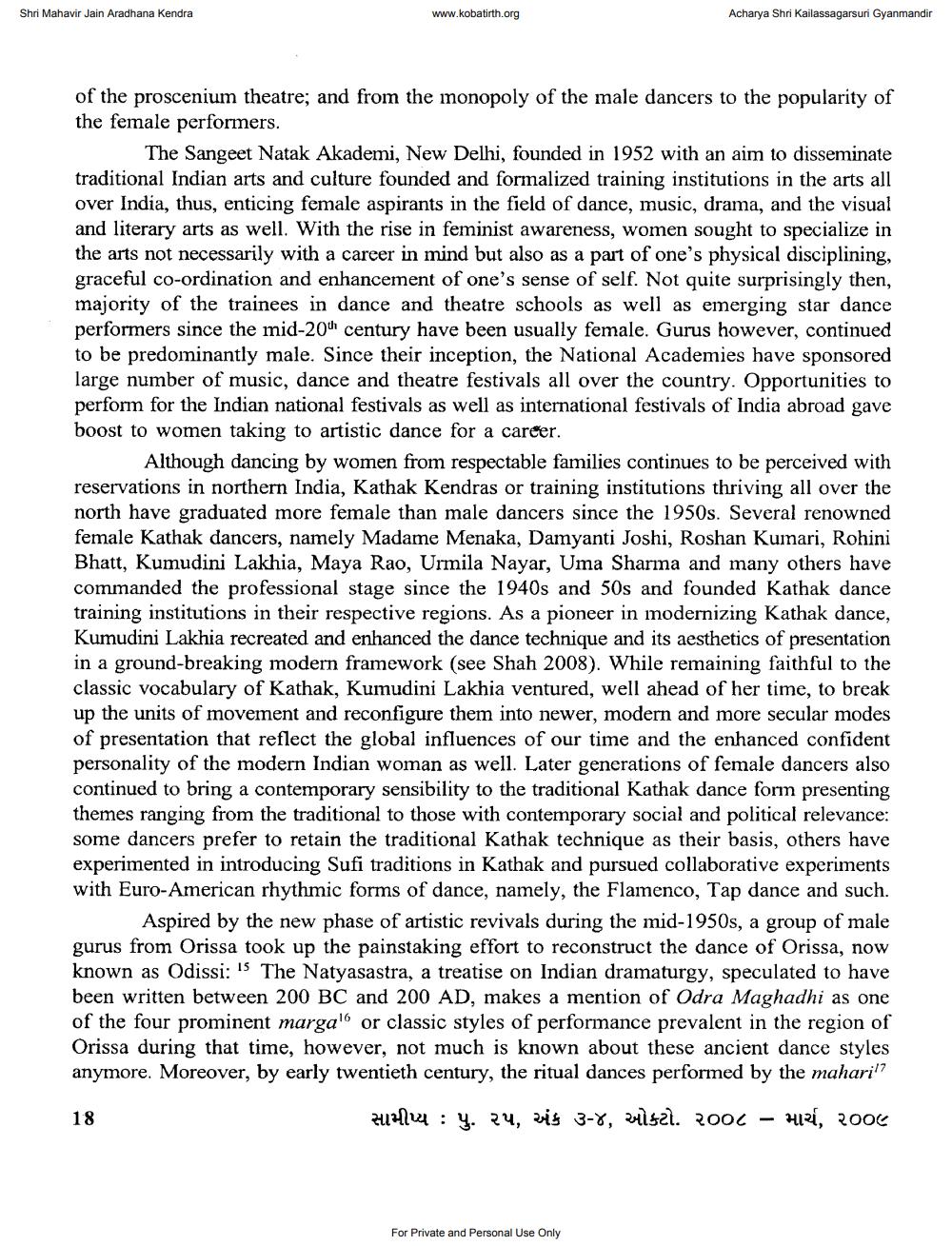________________
Shri Mahavir Jain Aradhana Kendra
www.kobatirth.org
of the proscenium theatre; and from the monopoly of the male dancers to the popularity of the female performers.
Acharya Shri Kailassagarsuri Gyanmandir
The Sangeet Natak Akademi, New Delhi, founded in 1952 with an aim to disseminate traditional Indian arts and culture founded and formalized training institutions in the arts all over India, thus, enticing female aspirants in the field of dance, music, drama, and the visual and literary arts as well. With the rise in feminist awareness, women sought to specialize in the arts not necessarily with a career in mind but also as a part of one's physical disciplining, graceful co-ordination and enhancement of one's sense of self. Not quite surprisingly then, majority of the trainees in dance and theatre schools as well as emerging star dance performers since the mid-20" century have been usually female. Gurus however, continued to be predominantly male. Since their inception, the National Academies have sponsored large number of music, dance and theatre festivals all over the country. Opportunities to perform for the Indian national festivals as well as international festivals of India abroad gave boost to women taking to artistic dance for a career.
18
Although dancing by women from respectable families continues to be perceived with reservations in northern India, Kathak Kendras or training institutions thriving all over the north have graduated more female than male dancers since the 1950s. Several renowned female Kathak dancers, namely Madame Menaka, Damyanti Joshi, Roshan Kumari, Rohini Bhatt, Kumudini Lakhia, Maya Rao, Urmila Nayar, Uma Sharma and many others have commanded the professional stage since the 1940s and 50s and founded Kathak dance training institutions in their respective regions. As a pioneer in modernizing Kathak dance, Kumudini Lakhia recreated and enhanced the dance technique and its aesthetics of presentation in a ground-breaking modern framework (see Shah 2008). While remaining faithful to the classic vocabulary of Kathak, Kumudini Lakhia ventured, well ahead of her time, to break up the units of movement and reconfigure them into newer, modern and more secular modes of presentation that reflect the global influences of our time and the enhanced confident personality of the modern Indian woman as well. Later generations of female dancers also continued to bring a contemporary sensibility to the traditional Kathak dance form presenting themes ranging from the traditional to those with contemporary social and political relevance: some dancers prefer to retain the traditional Kathak technique as their basis, others have experimented in introducing Sufi traditions in Kathak and pursued collaborative experiments with Euro-American rhythmic forms of dance, namely, the Flamenco, Tap dance and such. Aspired by the new phase of artistic revivals during the mid-1950s, a group of male gurus from Orissa took up the painstaking effort to reconstruct the dance of Orissa, now known as Odissi: 5 The Natyasastra, a treatise on Indian dramaturgy, speculated to have been written between 200 BC and 200 AD, makes a mention of Odra Maghadhi as one of the four prominent marga" or classic styles of performance prevalent in the region of Orissa during that time, however, not much is known about these ancient dance styles anymore. Moreover, by early twentieth century, the ritual dances performed by the mahari"?
સામીપ્ય : પુ. ૨૫, અંક ૩-૪, ઓક્ટો. ૨૦૦૮ - માર્ચ, ૨૦૦૯
For Private and Personal Use Only




